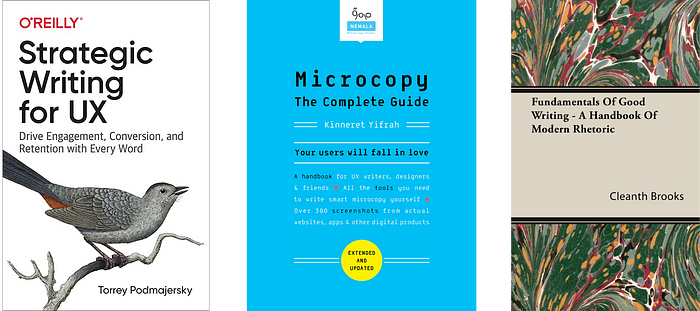

6 essential UX writing books
source link: https://uxplanet.org/6-essential-ux-writing-books-3d2709465b45
Go to the source link to view the article. You can view the picture content, updated content and better typesetting reading experience. If the link is broken, please click the button below to view the snapshot at that time.

6 essential UX writing books
Read these before you take any expensive courses.

Torrey Podmajersky — ‘Strategic Writing for UX’ [2019]
Have you ever wondered what processes and methods you can use to elevate your UX copy? Or indeed how to simply measure UX copy effectiveness? This fantastic bible answers these questions, along with addressing tons of other strategic queries for content designers and UX writers.
Podmajersky’s work also offers handy insights into how UX content can function within a software development lifecycle.
Basically, essential reading.
Kinneret Yifrah — ‘Microcopy: The Complete Guide’ [2019]
This edition should be on the shelf of every UX writer and content designer, and is handy for product designers and (other) product people too.
Yifrah systematically addresses some of the most common challenges facing organisations when establishing a UX writing culture.
Starting with the basics, Yifrah tackles:
- The definition of microcopy
- Voice and tone
- Experience and engagement
- Usability
There are also neat tips peppered through the book addressing hot topics such as ‘humor in error messages — yes or no?’
Cleanth Brooks — ‘Fundamentals of Good Writing — A Handbook of Modern Rhetoric’ [1950]
This is a timeless classic from a well-known American literary critic. It addresses basic principles that apply to all writing disciplines, including UX writing (although of course, this term didn’t exist 70 years ago!)
For example:
- Coherence — ‘an effective discourse must have unity…’
- Emphasis — ‘When this principle is properly observed the intended scale of importance of elements in the discourse is clear to the reader.’
- Exposition — ‘Exposition is the most common kind of writing, for it is applicable to anything which challenges the understanding…’
Brooks also delivers a beautifully rendered overview of the writer condition if you will, tackling skills, techniques, and common problems.

William Zinnser — ‘On Writing Well’ [1976]
If you can only buy one book about writing, make it this one.
Born out of Zinnser’s writing lectures at Yale back in the ’70s, ‘On Writing Well’ delivers a warm, charming and wise take on the craft of non-fiction writing.
Honestly, it is difficult to summarise the magic, essentially Zinnser walks through fundamental principles that lead to mastery:
- Best practices for good writing — ‘clear, simple, concise and human’
- The anatomy of writing well — ‘writing that endures consists of words that are short and strong’
- How to side-step sexism — ‘use alternatives for sexist nouns, e.g. chairman → chair’
This book is truly a UX writing bible and was written 35 years before the term was in common circulation.
Sarah Richards — ‘Content Design’ [2017]
Another absolute classic from the British author and celebrated content designer.
This was the first book I read about content design, and it really opened my mind.
Richards discusses the practical application of content design principles, and some of the challenges content designers face in a professional environment.
Here are some revelations, in Richards’ words:
- ‘Don’t force readers to work your way. Work theirs.’
- ‘I’ve found the best way to get the rest of the organisation to agree with my work and approach is to run a workshop where all the right people are together.’
- ‘A good content designer understands a bit about the involuntary mechanics that govern how humans take in information.’
The book also refers to other relevant and interesting UX concepts, such as the ‘scent of information’.
Clifford Nass — ‘The Man Who Lied To His Laptop’ [2010]
Here, Stanford professor Clifford Nass investigates the way that humans communicate with technology.
Using real experiments as evidence, the book reveals some fascinating insights about ourselves, gleaned from examining our interaction with computers.
Some of the key takeaways from the book:
- Extroverts are best writing for extroverts, and introverts best writing for introverts
- Mixing criticism and praise is an ineffective method of evaluation
- Flattery works, even when the recipient knows it’s fake
Nass argues that we treat technological entities (such as digital products) like humans — we can feel empathy for them, get annoyed with them and lie to them.
Another must-read to gain some valuable insights on UX writing and its place in the realm of technology and communication.
Recommend
About Joyk
Aggregate valuable and interesting links.
Joyk means Joy of geeK